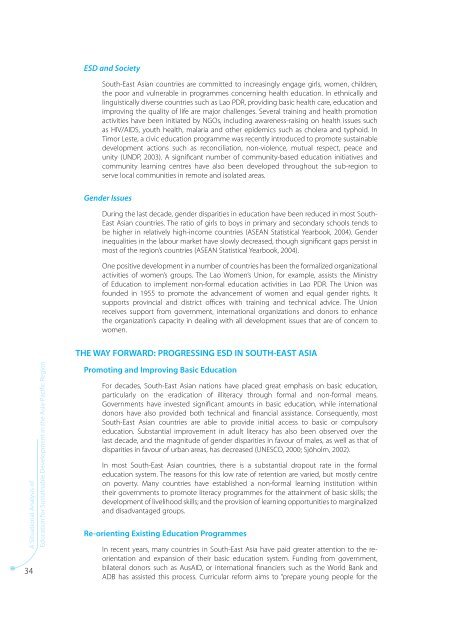A Situational Analysis - UNESCO Bangkok
A Situational Analysis - UNESCO Bangkok
A Situational Analysis - UNESCO Bangkok
Create successful ePaper yourself
Turn your PDF publications into a flip-book with our unique Google optimized e-Paper software.
ESD and Society<br />
South-East Asian countries are committed to increasingly engage girls, women, children,<br />
the poor and vulnerable in programmes concerning health education. In ethnically and<br />
linguistically diverse countries such as Lao PDR, providing basic health care, education and<br />
improving the quality of life are major challenges. Several training and health promotion<br />
activities have been initiated by NGOs, including awareness-raising on health issues such<br />
as HIV/AIDS, youth health, malaria and other epidemics such as cholera and typhoid. In<br />
Timor Leste, a civic education programme was recently introduced to promote sustainable<br />
development actions such as reconciliation, non-violence, mutual respect, peace and<br />
unity (UNDP, 2003). A significant number of community-based education initiatives and<br />
community learning centres have also been developed throughout the sub-region to<br />
serve local communities in remote and isolated areas.<br />
Gender Issues<br />
During the last decade, gender disparities in education have been reduced in most South-<br />
East Asian countries. The ratio of girls to boys in primary and secondary schools tends to<br />
be higher in relatively high-income countries (ASEAN Statistical Yearbook, 2004). Gender<br />
inequalities in the labour market have slowly decreased, though significant gaps persist in<br />
most of the region’s countries (ASEAN Statistical Yearbook, 2004).<br />
One positive development in a number of countries has been the formalized organizational<br />
activities of women’s groups. The Lao Women’s Union, for example, assists the Ministry<br />
of Education to implement non-formal education activities in Lao PDR. The Union was<br />
founded in 1955 to promote the advancement of women and equal gender rights. It<br />
supports provincial and district offices with training and technical advice. The Union<br />
receives support from government, international organizations and donors to enhance<br />
the organization’s capacity in dealing with all development issues that are of concern to<br />
women.<br />
THE WAY FORWARD: PROGRESSING ESD IN SOUTH-EAST ASIA<br />
<br />
34<br />
<br />
Promoting and Improving Basic Education<br />
For decades, South-East Asian nations have placed great emphasis on basic education,<br />
particularly on the eradication of illiteracy through formal and non-formal means.<br />
Governments have invested significant amounts in basic education, while international<br />
donors have also provided both technical and financial assistance. Consequently, most<br />
South-East Asian countries are able to provide initial access to basic or compulsory<br />
education. Substantial improvement in adult literacy has also been observed over the<br />
last decade, and the magnitude of gender disparities in favour of males, as well as that of<br />
disparities in favour of urban areas, has decreased (<strong>UNESCO</strong>, 2000; Sjöholm, 2002).<br />
In most South-East Asian countries, there is a substantial dropout rate in the formal<br />
education system. The reasons for this low rate of retention are varied, but mostly centre<br />
on poverty. Many countries have established a non-formal learning institution within<br />
their governments to promote literacy programmes for the attainment of basic skills; the<br />
development of livelihood skills; and the provision of learning opportunities to marginalized<br />
and disadvantaged groups.<br />
Re-orienting Existing Education Programmes<br />
In recent years, many countries in South-East Asia have paid greater attention to the reorientation<br />
and expansion of their basic education system. Funding from government,<br />
bilateral donors such as AusAID, or international financiers such as the World Bank and<br />
ADB has assisted this process. Curricular reform aims to “prepare young people for the

















